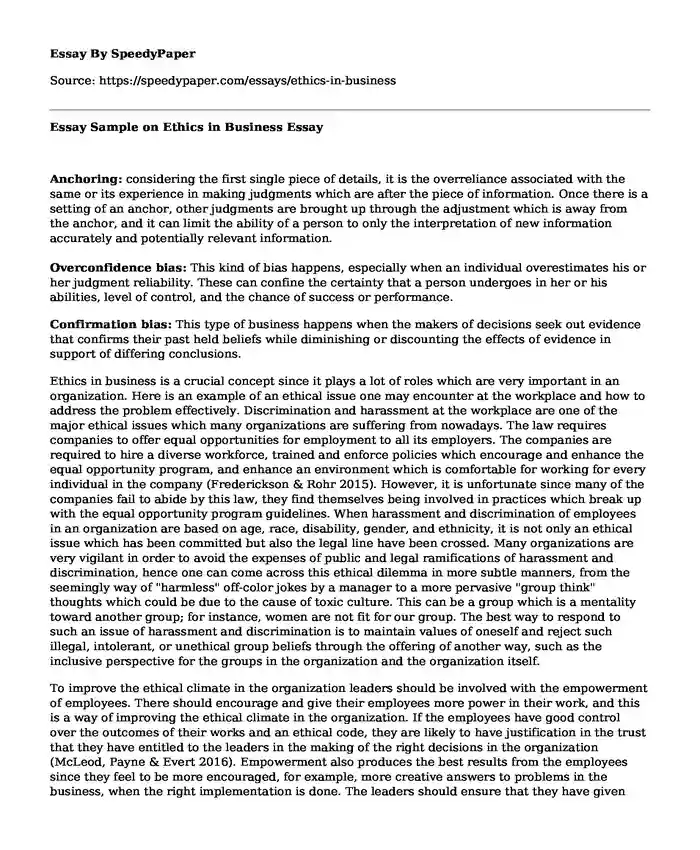
| Type of paper: | Research paper |
| Categories: | Discrimination Business ethics Ethical dilemma Employment law |
| Pages: | 3 |
| Wordcount: | 823 words |
Anchoring: considering the first single piece of details, it is the overreliance associated with the same or its experience in making judgments which are after the piece of information. Once there is a setting of an anchor, other judgments are brought up through the adjustment which is away from the anchor, and it can limit the ability of a person to only the interpretation of new information accurately and potentially relevant information.
Overconfidence bias: This kind of bias happens, especially when an individual overestimates his or her judgment reliability. These can confine the certainty that a person undergoes in her or his abilities, level of control, and the chance of success or performance.
Confirmation bias: This type of business happens when the makers of decisions seek out evidence that confirms their past held beliefs while diminishing or discounting the effects of evidence in support of differing conclusions.
Ethics in business is a crucial concept since it plays a lot of roles which are very important in an organization. Here is an example of an ethical issue one may encounter at the workplace and how to address the problem effectively. Discrimination and harassment at the workplace are one of the major ethical issues which many organizations are suffering from nowadays. The law requires companies to offer equal opportunities for employment to all its employers. The companies are required to hire a diverse workforce, trained and enforce policies which encourage and enhance the equal opportunity program, and enhance an environment which is comfortable for working for every individual in the company (Frederickson & Rohr 2015). However, it is unfortunate since many of the companies fail to abide by this law, they find themselves being involved in practices which break up with the equal opportunity program guidelines. When harassment and discrimination of employees in an organization are based on age, race, disability, gender, and ethnicity, it is not only an ethical issue which has been committed but also the legal line have been crossed. Many organizations are very vigilant in order to avoid the expenses of public and legal ramifications of harassment and discrimination, hence one can come across this ethical dilemma in more subtle manners, from the seemingly way of "harmless" off-color jokes by a manager to a more pervasive "group think" thoughts which could be due to the cause of toxic culture. This can be a group which is a mentality toward another group; for instance, women are not fit for our group. The best way to respond to such an issue of harassment and discrimination is to maintain values of oneself and reject such illegal, intolerant, or unethical group beliefs through the offering of another way, such as the inclusive perspective for the groups in the organization and the organization itself.
To improve the ethical climate in the organization leaders should be involved with the empowerment of employees. There should encourage and give their employees more power in their work, and this is a way of improving the ethical climate in the organization. If the employees have good control over the outcomes of their works and an ethical code, they are likely to have justification in the trust that they have entitled to the leaders in the making of the right decisions in the organization (McLeod, Payne & Evert 2016). Empowerment also produces the best results from the employees since they feel to be more encouraged, for example, more creative answers to problems in the business, when the right implementation is done. The leaders should ensure that they have given their employees a reason to be ethically behaved and be innovative to keep their autonomy in their work; this will eventually increase the efficiency of the organization.
Communication procedures and policies is also another issue to consider in the improvement of ethical climate I organizations. This enhances a better flow of information in the company between the managers and the employees in a more frequent and smooth manner. These case helps the managerial sector to be able to communicate the needed ethical behaviors in the company to the employees effectively and in time. In addition, it makes it easier for the employees to be able to report unethical behavior to the managerial sector by contacting of an outside service. To give a toll-free hotline for reporting, and ensure any complaints are investigated immediately, and the required action employed instantly. Also, the leaders should ensure that in the case of indiscipline cases, the employees or the concerned individual have been disciplined accordingly (McLeod, Payne & Evert 2016). They should enforce consequences in case of the violation of policies made on the ethics code, regardless of whether the person is a normal employee or a manager in the company.
References
Frederickson, H. G., & Rohr, J. A. (2015). Ethics and public administration. Routledge.
McLeod, M. S., Payne, G. T., & Evert, R. E. (2016). Organizational ethics research: A systematic review of methods and analytical techniques. Journal of Business Ethics, 134(3), 429-443.
Cite this page
Essay Sample on Ethics in Business. (2023, Feb 10). Retrieved from https://speedypaper.com/essays/ethics-in-business
Request Removal
If you are the original author of this essay and no longer wish to have it published on the SpeedyPaper website, please click below to request its removal:
- Multitasking in the Game Industry. Free Essay on Project Management.
- Acting on Emotions, Free Essay for Everyone
- Religion Essayy Sample: The Promises of God and the Bible
- Paper Example: U.S. Customs and Border Protection Challenges
- Paper Example. The Law on Penalties
- Paper Example: Atlantic Revolutions in the Period Between 1800 and 1914
- Essay Sample on The Declaration of Independence 1776
Popular categories




